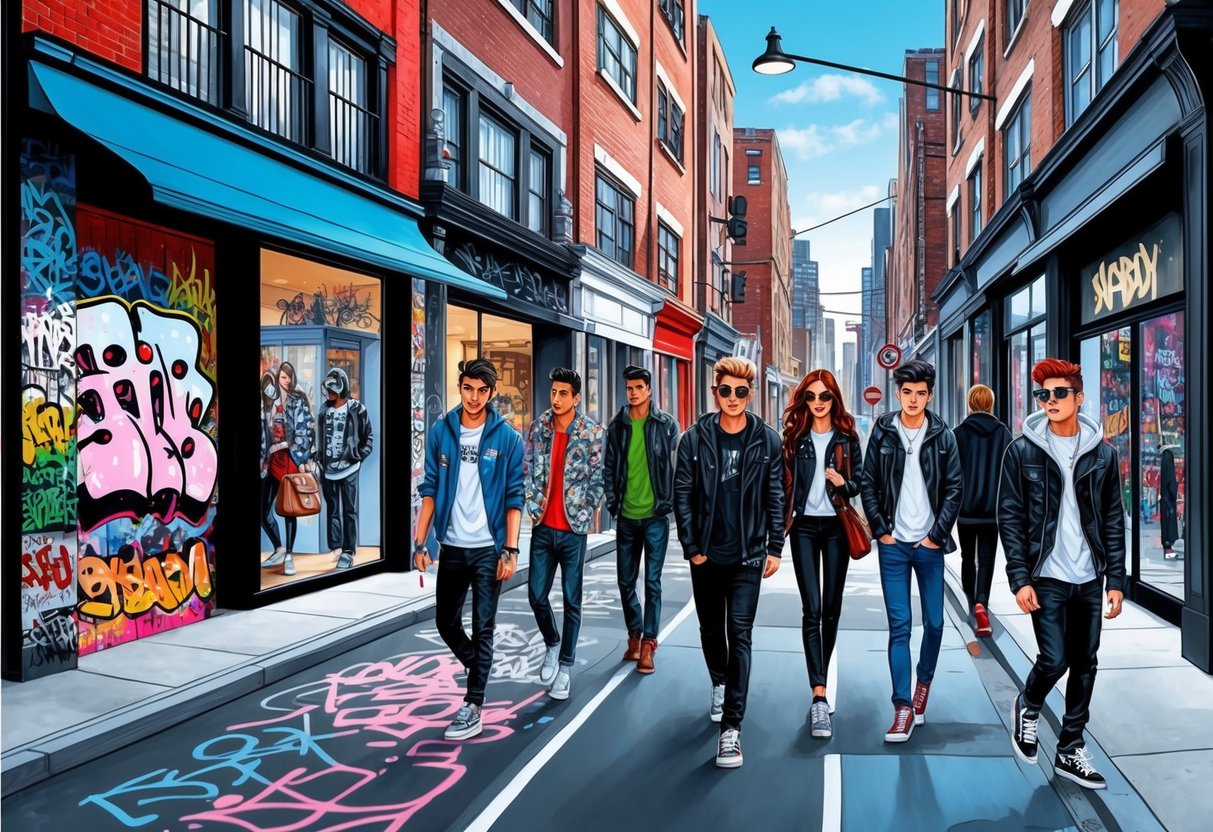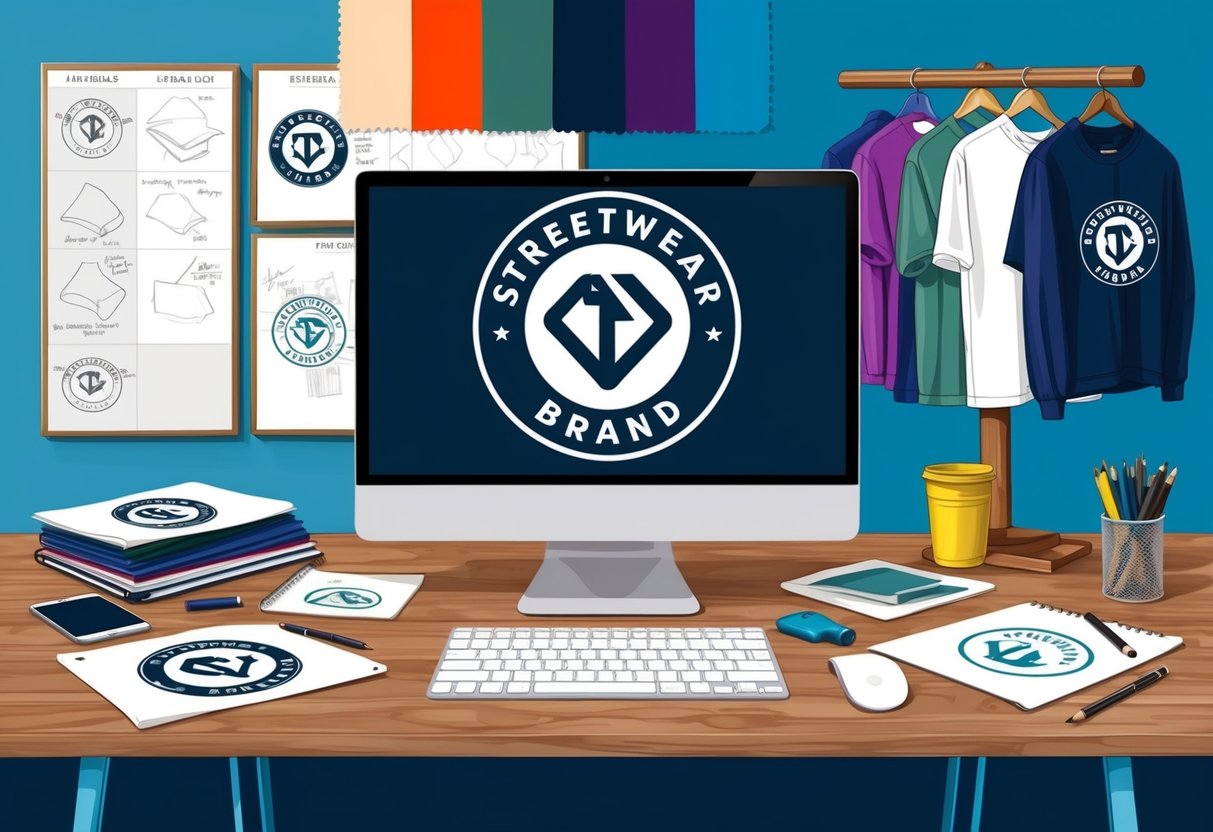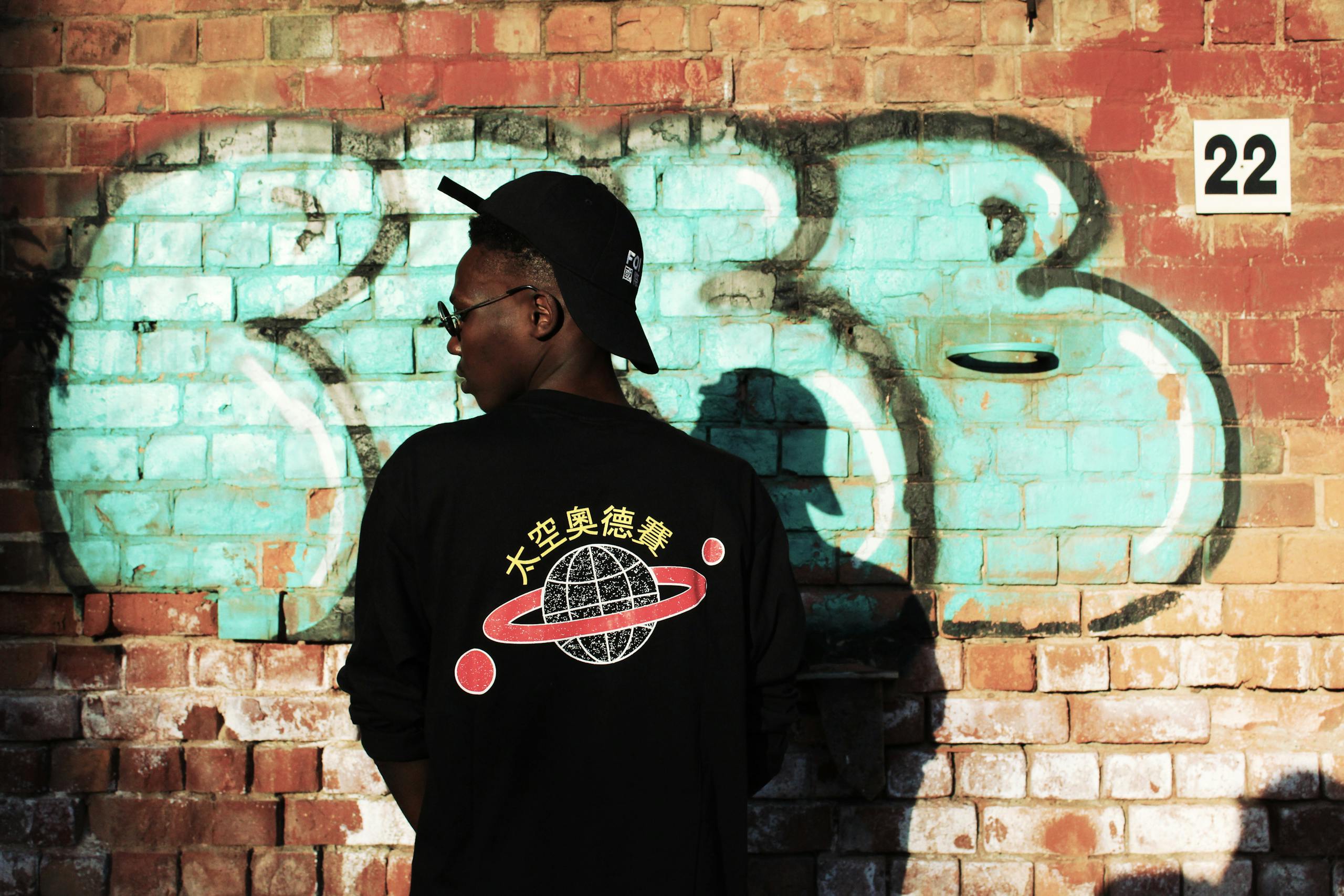Starting a streetwear brand might seem daunting, but with the right guidance, it’s an achievable goal.
To succeed, you need to focus on understanding your target market, developing a unique style, and building a strong brand identity.
Streetwear is all about blending fashion with culture, so having a clear vision of your brand’s message is essential.

Once you have a concept in place, the next step is creating standout designs.
This involves not only designing clothing but also crafting a brand image that resonates with your audience.
You’ll want to start with small, manageable steps, like creating a few initial designs and testing them in the market. This approach helps you to refine and grow your brand over time without overextending yourself.
Marketing plays a crucial role in establishing your streetwear label.
With a solid online presence, you can connect with customers and expand your reach.
Utilize social media and other digital marketing tools to showcase your unique designs and engage with your audience.
By consistently delivering value and keeping up with trends, your brand can thrive in the competitive world of streetwear.
Understanding Streetwear

Streetwear has become a significant part of the fashion industry, with roots in various cultures. Its growth has been influenced by music genres like hip-hop and rap, while also making a substantial impact on global fashion trends.
The Evolution of Streetwear
Streetwear originated from the 1980s and 1990s street styles. It started in California, influenced by surf and skate cultures. Early brands were small, and their appeal was based on exclusivity and limited releases.
Over time, streetwear found a broader audience. It evolved to include elements from punk, Japanese street fashion, and even high fashion. As these styles merged, streetwear became a dynamic blend of comfort, individuality, and bold statements. Now, it is a multi-billion dollar global industry with a strong presence.
Influence of Hip-Hop and Rap Culture
Hip-hop and rap have played crucial roles in shaping streetwear. Rappers turned into style icons, promoting brands and styles directly from the streets. Their music and personal style emphasized authenticity, which resonated with fans.
Artists like Run DMC, Kanye West, and Pharrell Williams have collaborated with fashion brands. This partnership boosted streetwear’s popularity. You see the influence in baggy pants, branded sneakers, and the use of bold logos and graphics. The crossover between music and fashion continues to define streetwear’s identity.
Streetwear’s Impact on Global Fashion
Streetwear has left a notable mark on global fashion. High-end designers now incorporate streetwear elements into their collections. You’ll find streetwear being featured prominently in fashion weeks around the world.
Major collaborations between traditional luxury brands and streetwear labels redefine what fashion means. The influence spreads across continents, intertwining with local cultures. Comfortable, everyday wear mixes with fashion-forward designs in new, exciting ways. This impact shows that streetwear isn’t just a trend but a lasting movement in the fashion landscape.
Planning Your Streetwear Brand

When starting a streetwear brand, it’s crucial to clearly define your niche, thoroughly research your market, and establish your brand’s identity and values. These steps will set the foundation for a successful venture.
Finding Your Niche
Choosing a niche is the first step in distinguishing your streetwear brand. Think about what unique perspective or theme sets your brand apart from others.
Study current trends in streetwear to identify gaps in the market.
Consider elements like culture, music, or lifestyle that can inspire your designs. Maybe you want to focus on eco-friendly materials or create limited-edition pieces. Tailor your niche to resonate with a specific audience who shares those interests.
Conducting Market Research
Market research helps you understand your audience and competition. Start by identifying your target demographic. This could include age, location, and lifestyle preferences.
Use social media surveys and online forums to gather insights into their tastes and buying habits.
Study competitors to learn what works and what doesn’t in the market. Analyze their pricing, marketing strategies, and product offerings.
By understanding your competition, you can find opportunities to stand out and cater to unmet needs.
Defining Brand Identity and Values
Your brand identity includes the visual elements and overall aesthetic of your streetwear line. Design a logo that embodies your style, using colors and fonts that appeal to your target audience. This logo will appear on your apparel and packaging, so make it memorable.
Consider your brand values as well. What principles will your streetwear line stand for? These values may include sustainability, community involvement, or inclusivity. They help to build a deeper connection with your audience and foster brand loyalty.
Creating Your Designs

Starting a streetwear brand involves crafting designs that catch the eye and stand out.
Focus on using powerful tools, developing a distinct style, and strategically incorporating logos and graphics to make your brand memorable.
Design Software and Tools
To create effective designs, begin with reliable design software. Adobe Illustrator and Photoshop are popular choices for crafting custom designs due to their comprehensive features. They allow you to handle vector graphics, which are essential for creating high-quality prints.
As an alternative, software like GIMP or Inkscape can serve those looking for free options.
These tools enable you to make graphic tees and explore different styles. Using online platforms like Kittl lets you design mockups to visualize how your creations will appear on clothing.
Developing a Unique Aesthetic
A strong aesthetic sets your streetwear brand apart. Start by understanding current trends while ensuring your designs reflect your personal style.
Look for inspiration in art, music, and culture. Consistency is key; aim to keep your brand’s look uniform across all items.
Experiment with colors, patterns, and fabrics to find a unique combination that speaks to your audience. Creating a mood board can help assemble your design ideas into a cohesive vision.
Incorporating Logos and Graphics
Incorporating logos and graphics effectively is crucial to brand identity. Your logo should be simple yet memorable, allowing it to stand out on clothing.
You might start by sketching ideas on paper or using digital tools to bring them to life.
Consider size, placement, and frequency of brand logos on outfits. Graphics should align with your brand’s story and resonate with your target market.
Paying attention to these details helps in creating consistent branding across all apparel.
Seeking feedback from trusted peers or potential customers can provide valuable insights into the effectiveness of your logos and graphics.
Production and Manufacturing

The production and manufacturing phase is crucial for creating a successful streetwear brand. It’s important to select high-quality materials, find a reliable manufacturer, and understand the steps involved in efficient production.
Selecting Quality Materials
Choosing the right materials is vital for product quality and brand reputation. Cotton, polyester, and denim are popular in streetwear. Look for materials that are durable yet comfortable.
Sustainability is also a key consideration. Opt for materials that minimize environmental impact, like organic cotton.
Talk to your suppliers and request material samples to ensure they meet your standards. Evaluate materials for texture, weight, and color. These factors will affect the look and feel of your clothing line. Also, consider how the materials will perform with different printing methods or embroidery.
Choosing the Right Manufacturer
A good manufacturer is essential for quality and reliability. You might look for local manufacturers to communicate easily and reduce shipping costs. Overseas manufacturers may offer lower prices but require more oversight.
Before committing, research potential manufacturers. Read reviews, visit facilities if possible, and ask for references.
Request samples of their previous work to assess quality and craftsmanship. Communication matters too, so ensure they understand your brand’s vision.
Create a detailed agreement outlining expectations, timelines, and costs. This helps prevent misunderstandings and ensures a smooth production process.
Understanding the Production Process
Understanding the production process is key to managing timelines and quality.
Begin with sampling. Creating samples allows you to test designs, fit, and fabric before full production. Adjust as needed based on sample feedback.
Choose between bulk production or print-on-demand. Bulk production offers lower costs per item but requires greater investment upfront. Print-on-demand minimizes waste and allows for flexibility, especially with online sales.
Quality control is critical. Inspect products at different stages to catch issues early. Set aside time for checks before products reach customers.
Clear communication with your manufacturer can prevent delays, ensuring your streetwear reaches high standards.
Building an Online Presence

To successfully start a streetwear brand, building a strong online presence is crucial. This involves using social media platforms like Instagram and TikTok, creating content that resonates with your audience, and forming partnerships with influencers.
Utilizing Social Media Platforms
Social media is a powerful tool to connect with your target market. Platforms like Instagram and TikTok allow you to showcase your streetwear designs and engage with potential customers.
Establish an account dedicated to your brand and maintain a consistent posting schedule.
Use Instagram Stories and TikTok videos to share sneak peeks of new designs or behind-the-scenes content. Engage with followers by responding to comments and messages, creating a sense of community.
Investing in paid advertising can also increase your visibility, reaching more potential customers.
Creating Engaging Content
Content is king when it comes to capturing attention online.
Focus on high-quality images and videos that reflect your brand’s identity. Use vibrant photos of your products to grab attention, and consider tutorials or styling tips to engage your audience further.
Encourage user-generated content by setting up a hashtag for your brand. This prompts customers to share their images wearing your clothes, which can build a loyal community.
Engaging content keeps customers returning and interested in future releases.
Leveraging Influencer Collaborations
Influencer collaborations can greatly expand your brand’s reach. Partnering with influencers who align with your brand offers credibility and exposes your streetwear to their followers.
Choose influencers with a suitable audience size and engagement rate.
Micro-influencers, often those with a smaller but highly engaged audience, can be particularly effective for niche brands.
Collaborations might include sponsored posts or having the influencer wear your clothing in their content. Clear agreements on deliverables and expectations are crucial for a successful collaboration.
Marketing and Sales Strategies

When starting a streetwear brand, it’s crucial to have effective marketing and sales strategies. You’ll want to build a unique brand story, use creative marketing tactics, and consider both online and physical retail spaces for selling your products.
Crafting Your Brand Story
Your brand story is the heart of your streetwear label. It should connect with your target audience on a personal level.
Use authentic narratives that reflect your brand’s values, culture, and vision. This might involve sharing the inspiration behind your designs or the journey that led to the brand’s creation.
Visual elements like logos, colors, and taglines are important. These should be consistent across all marketing materials. Make sure your story engages and resonates with customers to foster brand awareness and loyalty.
Innovative Marketing Tactics
Adopt unconventional marketing strategies to capture attention.
Collaborate with influencers in the streetwear community to expand your reach. This can help you tap into their follower base and establish credibility.
Leverage social media platforms like Instagram and TikTok to showcase new collections and engage with potential customers.
Experiment with strategies like limited product drops to create exclusivity and demand.
Partner with other brands for special editions or events, blending audiences and enhancing visibility.
E-commerce and Retail Considerations
E-commerce is vital for streetwear brands. Focus on creating a seamless online shopping experience.
Ensure your website is user-friendly and visually appealing. Offer diverse payment options and reliable shipping methods. Provide detailed descriptions and images to help customers make informed choices.
Consider a mix of online and offline sales channels. Pop-up shops or collaborations with local retailers can provide a physical presence. This allows customers to experience your products firsthand and boosts brand credibility.
Keep track of sales data to understand customer preferences and adjust your strategies accordingly.
Building a Community and Following

Creating a strong community around your streetwear brand is key to success. Engage directly with your audience through collaborations and exclusive events to foster loyalty and enthusiasm for your brand.
Fostering a Loyal Community
Interacting with your community builds trust and loyalty. Social media is an indispensable tool for connecting with your audience.
Regularly engaging through posts, stories, and live sessions can create a consistent brand presence.
Online platforms are great, but in-person interactions can make a bigger impact. Organize meetups and pop-up shops where fans can experience your brand firsthand.
Encourage feedback and involve your audience in decision-making to make them feel valued.
Collaborating with Artists and Creatives
Working with artists and creatives brings fresh ideas and expands your reach. Look for local talent to bring authenticity and diversity to your designs.
Collaborations can also include musicians or influencers who resonate with your brand’s ethos.
You can create limited edition pieces that highlight the unique touch from these collaborations. If possible, host co-branded events where artists showcase their work. This not only promotes your brand but also introduces your community to new creative expressions.
Hosting Exclusive Events
Exclusivity drives excitement and interest in the streetwear community. Hosting exclusive events such as launch parties or fashion shows can generate buzz around your brand.
These events should cater to your community, offering them a chance to engage with your products in a memorable way.
Provide VIP access to limited-edition releases or sneak peeks of new collections. This can make your community feel special and appreciated. Always capture these moments through photos and videos to share online, letting those unable to attend feel a part of the action too.
Managing the Business

When starting a streetwear brand, it’s crucial to effectively manage operations. This includes handling inventory and supply chains, providing excellent customer service, and implementing sustainable business practices.
Inventory and Supply Chain Management
Efficient inventory management is key to a successful streetwear brand.
Maintain a balance between having enough stock to meet demand and avoiding excess that ties up resources. Use technology like inventory management software to track stock levels in real-time.
Consider the supply chain carefully. Build relationships with reliable suppliers who provide quality materials at competitive prices.
Decide if you will produce locally or internationally. Local production often offers quicker turnaround times but might be costlier. International production can save money but may include longer lead times and shipping complexities.
Excellent Customer Service
Exceptional customer service can set your brand apart in the streetwear market.
Ensure that communication with customers is clear and timely. Respond to inquiries and complaints quickly, understanding this builds trust and loyalty.
Consider offering multiple channels for customer interaction. This can include email, social media, or live chat options.
Train your team to handle all issues professionally and personally. Providing a return or exchange policy that’s fair and straightforward will enhance customer satisfaction. Happy customers are more likely to become repeat buyers and refer others to your brand.
Sustainable Business Practices
Incorporating sustainable practices into your business benefits both the environment and your brand’s image.
Consider using eco-friendly materials in your fashion line, like organic cotton or recycled fibers.
Audit your production process to minimize waste and reduce your carbon footprint. Efficient energy use and waste reduction contribute to sustainability. Transparency in your operations can enhance public perception.
Engaging in sustainability not only helps the planet but can attract eco-conscious consumers. Marketing your commitment to sustainability can make a strong fashion statement, aligning your values with your audience.
The Future of Streetwear

The streetwear market is evolving rapidly, influenced by new trends and shifts in consumer behavior. For those in the industry, understanding these changes is crucial to staying competitive and relevant.
Emerging Trends in Streetwear
Streetwear is constantly shaped by cultural and fashion influences. This year, expect an increase in sustainable materials as the environmental impact becomes a major concern.
Consumers are looking for eco-friendly options with a focus on recycled fabrics.
Moreover, gender-neutral clothing is gaining traction. Brands are exploring more inclusive designs, moving past traditional gender roles. This broadens their appeal to a larger audience.
Additionally, collaborations between streetwear brands and luxury labels continue to be popular. These partnerships create a blend of street style with high fashion, attracting diverse customer bases and setting new style standards.
Adapting to Consumer Behavior Changes
Understanding consumer behavior is key for a successful streetwear brand.
Many streetwear consumers, particularly Gen Z, value authenticity and personal connections with brands. They are likely to engage with labels that share their values and stories.
Digital presence is crucial. Consumers now rely heavily on social media and online platforms for purchasing decisions. Brands should leverage these channels for storytelling and to engage with their audience effectively.
Affordability is another point to focus on, as a significant portion of the streetwear crowd earns under $40,000 annually yet is willing to spend substantially on fashion. Offering a range of pricing options can cater to this market’s needs while maintaining brand integrity.
Innovation and the Next Generation
Innovation plays a critical role in the future of streetwear.
Brands should embrace new technologies like augmented reality (AR) and virtual reality (VR) to create unique shopping experiences. These technologies can also help in developing more personalized and interactive experiences for the consumer.
Sustainability continues to be an innovation driver. Exploring biodegradable materials and advanced recycling methods allows brands to address environmental concerns while pushing design boundaries.
As streetwear evolves, engaging with young designers and influencers can bring fresh perspectives. This approach keeps brands aligned with the interests of Gen Z and ensures they remain relevant in an ever-changing market. Embracing innovation will define the next phase of streetwear.
Frequently Asked Questions

Starting a streetwear brand involves understanding the market, creating a unique brand identity, and managing production. Knowing the challenges and strategies can help in building and growing a successful business.
What are the initial steps to establish a streetwear label from scratch?
Begin by defining your target market and creating a strong brand identity. Decide on how you will produce your clothing, whether through print-on-demand or traditional manufacturing.
What are key strategies for growing a new streetwear fashion brand?
Build a community around your brand through social media engagement and collaborations with influencers. Consistently deliver quality products and keep up with fashion trends to attract and retain customers.
How can one start a successful clothing line with limited experience?
Research thoroughly to understand the industry, and start simple by focusing on a few core products. Consider using print-on-demand services to test designs and reduce upfront costs.
What factors contribute to the profitability of a streetwear brand?
Profitability depends on cost management, pricing strategy, and brand perception. Opt for efficient production methods and set competitive prices to balance quality and cost.
What are the challenges faced when launching a streetwear brand?
Challenges include finding the right production partners, maintaining quality control, and standing out in a competitive market. It’s also crucial to effectively manage finances and marketing efforts.
How does one create a distinct identity for a streetwear brand?
Develop a unique style and voice that resonates with your target audience.
Use creative designs and meaningful branding elements that differentiate your brand from competitors.


